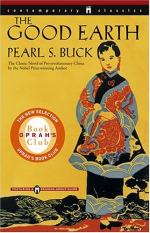|
This section contains 259 words (approx. 1 page at 400 words per page) |

|
The Good Earth Summary & Study Guide Description
The Good Earth Summary & Study Guide includes comprehensive information and analysis to help you understand the book. This study guide contains the following sections:
This detailed literature summary also contains Bibliography on The Good Earth by Pearl S. Buck.
Pearl Buck was one of the most widely read American novelists of the twentieth century. When she published her most popular and critically acclaimed novel, The Good Earth, in 1931, she was living in China as the wife of a Christian missionary. By that time, she had lived in China for about forty years and brought to her portrayal of Chinese rural life a knowledge that few if any Western writers have possessed.
The novel is about a poor farmer named Wang Lung who rises from humble origins to become a rich landowner with a large family. Although Wang Lung is a fundamentally decent man, as he becomes wealthy and acquires a large townhouse he becomes arrogant and loses his moral bearings, but he manages to right himself by returning to the land, which always nourishes his spirit.
The The Good Earth contains a wealth of detail about daily life in rural China at the end of the nineteenth century and in the first quarter of the twentieth century; it shows what people ate, what clothes they wore, how they worked, what gods they worshiped, and what their marriage and family customs were. The novel is written in a simple but elevated, almost Biblical style, which lends dignity to the characters and events. It was widely praised for presenting American readers with an accurate picture of a country about which they knew very little in the 1930s. As of 2006, The Good Earth had never been out of print and had sold millions of copies in many different languages.
Read more from the Study Guide
|
This section contains 259 words (approx. 1 page at 400 words per page) |

|



